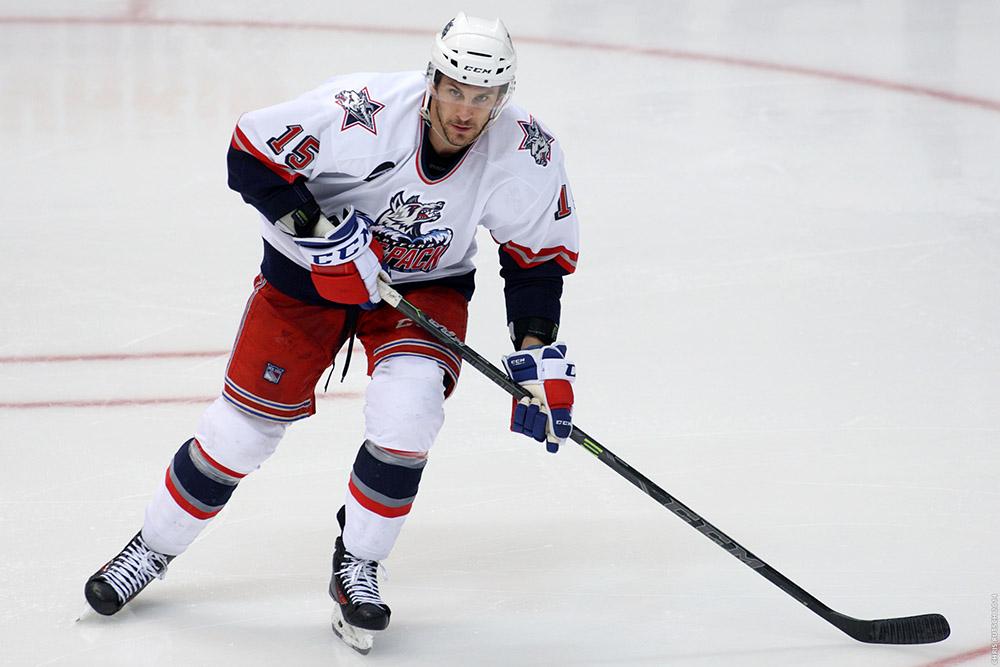by Bob Crawford | AHL On The Beat Archive
When Marek Hrivik burst on to the Connecticut Whale’s scene at the end of the 2011-12 season, as a virtual unknown out of the Quebec Major Junior Hockey League, it appeared as though the New York Rangers organization might have uncovered a hidden offensive gem.
Then 20 years old, the Slovakian import was the leading playoff goal-scorer that spring for a Whale club that had a solid postseason run, and tied for the team lead in playoff points.
Hrivik was unable to replicate that scoring pace in either of his first two full pro seasons, but still had reasonable offensive success, notching seven goals and 25 points in 40 games in an injury-shortened rookie campaign and amassing 13 goals and 27 points in 74 games last season.
This year, however, started out as one long scoring drought for the Zilina, Slovakia native. He lit the lamp in the season opener on October 12 in Syracuse, but then managed only one goal and one assist in the next 22 games. His all-around game seemed fine, but the points just wouldn’t come, until head coach Ken Gernander installed him for a stint at center between team scoring leader Chris Bourque and long-time NHL stalwart Ryan Malone. That assignment led to back-to-back two-assist games for Hrivik, and a run of five helpers in three games.
“The chances have been there all season,” Hrivik said recently. “I’ve had a lot of chances to score goals and my teammates have too, but I just couldn’t put the puck in the net. I hope this just started a new thing and it’s going to keep going for the rest of the season.”
The opportunity to play with Bourque and Malone obviously provided a jump-start for Hrivik’s point numbers, and Hrivik felt it was a solid combination.
“We were pretty much balanced out there,” he said. “We knew [Bourque] was going to make the plays, I tried to dig the pucks out of the corners for them, [Malone’s] got a strong, big body, he’s in front of the net. We just tried to trust each that everyone was going to do their job.”
Centering for a high-end offensive wizard like Bourque, who has an AHL scoring title to his credit, has kept Hrivik consistently on his toes.
“You’ve got to expect that he is going to pass it to you all of the time, you’ve just got to be ready for your opportunities,” Hrivik said. “He doesn’t dump a lot of pucks in, so you’ve got to be ready to get them and go. That’s the biggest thing; you’ve got to be ready to receive those pucks.
“He’s a goal-scorer, too,” Hrivik pointed out in regards to Bourque. “His game is pretty balanced, he’s got a good pass and he’s got a good shot, and we’ve just got to try and get him the puck.”
That element of the game has seemed to flow particularly well, with two recent Bourque goals being set up by pinpoint passes from Hrivik.
“You’re linemates, you’ve got to trust each other,” Hrivik said. “He’s got to trust that I’m going to hit his stick, and I’ve got to trust that he’s going to hold his stick tight and he’s going to put it in the net. Those are just the little details that make the difference in a game.”
“Details” is a word that one hears a lot in the game of hockey today, and Hrivik points to Malone as a player who exemplifies what attention to detail is all about.
“He never panics with the puck on the walls, every time he touches the puck he’s got a purpose,” Hrivik said of Malone. “It never goes just blindly somewhere in the middle of the rink. That’s something I’m trying to learn from him.”
Hrivik was a winger throughout his three-year QMJHL career with the Moncton Wildcats, and started out with the Whale on the wing, but quickly struck Gernander and his staff as a player who had the stuff to be a centerman. That sort of transition can be tough, especially for a young player, but Hrivik has consistently proven that versatility is one of his strengths.
“I’ve been playing center most of the time this year, so I’m just trying to work on my draws,” he said. “It’s improved a little bit the last few games, but center is more responsibility. You’ve got to be good offensively, but you’ve also got to backcheck and play in the defensive zone. So it’s a little bit harder, but I think I’m doing well so far, I’ve just got to keep it going.
“The biggest adjustment is the faceoffs,” he said of the move from wing to the middle. “Basically, the first man back on the backcheck is always trying to be the low guy. So it’s not like every time in the D zone I’m the low guy. It’s the faceoffs that make the biggest difference.”
The flexible mindset that has made Hrivik a highly-coachable prospect began in junior, where Hrivik started receiving the message of what kind of play was required if one was to have a chance of succeeding at hockey’s top level.
“Our coach in Moncton was Danny Flynn, who is currently with Buffalo, he’s an assistant, and he was a really good coach," Hrivik said. “He was trying to teach us that NHL kind of way, you can’t turn the puck over and you’ve got to be responsible. It kind of started there, making strong decisions, not just throw the pucks away blindly, and I’m trying to use that as well as I can now.
“Right now, if you want to play in the National Hockey League you’ve got to be a complete player. You’ve got to be good on both sides of the ice, you’ve got to be good defensively and offensively. I’m trying to balance my game, and just be as good as I can at everything.”






































